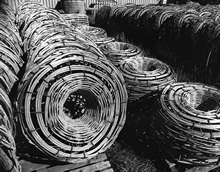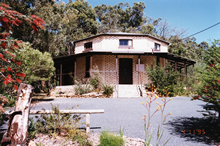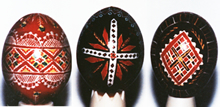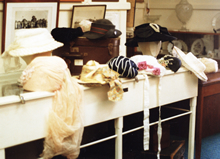
'Folklore provides an insight into the most powerful motivators of social groups. Its close relationship to sense of identity and belonging imparts shared meaning to the lives of individuals...' [1]
Australian Folklore Research Unit
The Australian Folklore Research Unit, established in March 2002 within Australian Studies in the Faculty of Humanities at Curtin, is at the heart of the folklore teaching and research at the University. Professor Graham Seal is the Director of the Unit.
However, engagement in folklore and folklife activities at Curtin pre-dates both the formation of the Folklore Research Unit and of the University itself. In 1985, prior to the Western Australian Institute of Technology (WAIT) becoming Curtin University of Technology, Graham Seal began teaching a folklore unit as part of the Bachelor of Arts degree in Australian Studies. He established the WA Folklore Archive at this time and the student fieldwork projects and Collect yourself questionnaires in the archive come from participants in this folklore unit.
Since 1999, Curtin University and Open Learning Australia have collaborated to offer a diploma level national course solely devoted to the study of folklore. [2] The course applies an understanding of folklife to a variety of social, cultural, organisational and human needs. It is aimed at professionals in human services, heritage studies, organisational behavior, human resources, tourism, museology, cultural planning, librarianship and teaching [3]. This course developed from the Graduate Diploma in Australian Folklife established by Gwenda Beed Davey in the 1990s as an onsite course at Monash University's National Centre for Australian Studies.
In addition to the Open Learning Australia course, folklore continues to be taught and researched at Curtin as part of Masters by Research and PhD programs. Research interests within the Australian Folklore Research Unit include: Australian folklore; global hero traditions; urban folklore; applied folklore; Australian cultural history; and Anglophone cultural traditions.

Image from student project
Making the 'beehive' or 'stickie' craypot
by Grant Synnot, 1995.
 Image of the Octagonal Hall,
Image of the Octagonal Hall, McGlew Road, Glen Forrest, 1995.
From student project Glen Forrest -
Proud to belong by Margaret Fowler, 1996.
Research Activities within the Folklore Research Unit
In addition to Professor Professor Graham Seal, the following key researchers are affiliated with the Unit:
- Dr Gwenda Davey, Deakin University
- Dr Robyn Mayes, Curtin University
- Mr Rob Willis, NLA
- Dr Dawn Bennett, Curtin University
Folklore researchers at WAIT and Curtin have initiated or collaborated with others to progress a number of significant research activities over the years, including the following:
1987 and ongoing: Publication of the journal Australian Folklore
Australian Folklore was founded by Graham Seal and Dave Hults, who co-edited the journal until 1993 when the editorship passed to John Ryan. A number of Western Australian related articles were published in the journal in its early years [4].
1987-1988: Chinese-Australian Folklore Project
In 1987 and 1988, the Curtin Folklore Unit organized the Chinese-Australian Folklore Project. The project was the result of a 1987 study tour by Australian folklorists who visited China at the invitation of the Chinese Folklore Literature and Art Society. Two Chinese folklorists, Feng Wei and Lin Zesheng, were funded by the Unit and the Myer Foundation to come to Perth as a return gesture to collect the folklore of the Chinese community over the summer period of 1987/88. Unfortunately the material resulting from this important collection work has been lost as a consequence of the Tianamen Square events and the subsequent loss of contact with the Chinese folklorists. A summary of the project was published in Davey, G. & Seal, G. (eds.) The Oxford Companion to Australian Folklore, Oxford University Press, 1993.[5].
1988-1989: Bibliography of Australian Folklore
The Bibliography of Australian Folklore, published in 1998 in Graham Seal's The Hidden Culture: Folklore in Australian Society (2nd ed., Black Swan Press, 1988) is now available online. It provides a selective list of important resources on genres of folklore including speech, narrative, song, poetry, music, foodways, art, craft, architecture, customs and folk heritage.
1988-1990: Foothills Connection Community Heritage Project
The Foothills Connection Community Heritage Project was jointly co-ordinated between the Shire of Kalamunda, the Library Board of WA and Curtin's Folklore Unit. The goal was to promote a sense of community identity in the Foothills area of Kalamunda Shire. Volunteers from the area were provided with training and then conducted oral history interviews with local residents. The project funded a musician-in-residence to collect and stimulate local music making activities. A photographer was also engaged to work with volunteers to research and create a visual record of the community's memories.
1992 and ongoing: Black Swan Press
Black Swan Press, co-founded by Graham Seal, was established in 1992 to publish research in folklore and related fields. In 1998, the Press published the second edition of Graham Seal's seminal folklore work The Hidden Culture: Folklore in Australian Society. [6] Black Swan Press continues to publish textbooks, histories, memoirs, guides, anthologies, bibliographies and other works of scholarship in both print and electronic formats.
2001 and ongoing: Legends of the West Project
The Legends of the West Project was jointly initiated in 2001 by Curtin's Folklore Unit, the West Australian newspaper and ABC Radio in WA with the aim of involving the WA community in collecting its own folk narrative traditions. The Project is ongoing and the stories gathered to date can be viewed online. The results have also been disseminated through the West Australian and ABC Radio websites. [7]
c 2001 and ongoing: Australian Folklore Network
The Australian Folklore Network was established by Curtin's Folklore Unit to maintain contact between Australian folklore collectors, researchers and performers. The network provides a way for the community to share ideas, information and news and to promote Australian folklore in the community. The Network produces a regular newsletter called Transmissions and since 2003 has facilitated the Australian Folklore Conference in conjuction with the National Library of Australia (NLA) and the National Folk Festival.
c 2001 and ongoing: National Register of Folklore Collections
The National Register of Folklore Collections is a joint project between Curtin's Folklore Unit and the Australian Folklore Network to compile a database of public and private folklore collections. The Register continues to evolve and aims to be a comprehensive and permanent record of the nature and availability of Australian folklore collections. Between an initial survey of collections in the 1980s and the development of the register in the early 2000s, researchers discovered a considerable number of collections had been 'lost'. This is a significant loss for Australia's cultural heritage. The Register is accessible through the Australian Folklore Network website.
2004 and ongoing: WA Folklife Project
The WA Folklife Project is a collaborative project between the National Library of Australia, Curtin's Folklore Research Unit and the Australian Folklore Network. Professional fieldworkers Olya and Rob Willis have visited WA each year since 2004, with the exception of 2008, to record and document local folklore.
2010 and ongoing: WA Folklore Archive - website and digital archive
The WA Folklore Archive was donated to Curtin University Library in 2008 by Graham Seal and the launch of the collection, website and digital archive took place in 2010. The collection is housed in the Library's John Curtin Prime Ministerial Library on the Bentley campus of Curtin University.
 Hand painted eggs, from student project Ukrainian Folklore in Australia by Bernice Cameron, 1991.
Hand painted eggs, from student project Ukrainian Folklore in Australia by Bernice Cameron, 1991.
 The Sheahan Family, image
The Sheahan Family, image
from student project Foodways
of the Sheahan Family,
1922-2001
by Kerry Sheahan, 2001.
 Image of a water tower at
Image of a water tower at Wedge Island.
From student project Folklore of
Wedge Island by Christine Eyres.
 A collection of ladies hats from 1909
A collection of ladies hats from 1909
to the 1960s from the collection of the Rockingham Museum.
From student project the Folklore of Rockingham by
Marilyn Baker, 1997.
 Image of the Armorial Bearings
Image of the Armorial Bearings
of the City of Subiaco, W.A.
From student project the Folklore of Subiaco by Yasmin McDonald, n.d.
 2 bumper stickers promoting
the
2 bumper stickers promoting
the
Curtin Billygoats Rugby Union Club.
From a student project by
Lisa Vance, 1996.
 |
||||||||